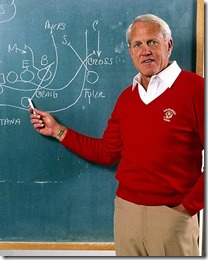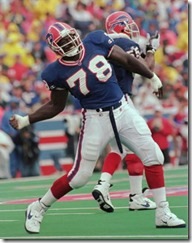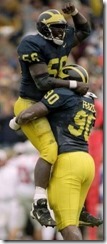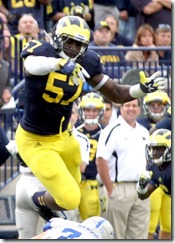Sinestral: Ross, Ryan and Clark|Bryan Fuller, MGoBlog. Dextral: Bill Walsh
First, a Chag Sameach to my fellow tribesmen and a Happy Turtleversary to the wingnuts.
We now continue with the Bill Walshian rundown of the 2013 roster. Since Michigan's offense and defense schemes are kindred spirits of the great 49er teams of the '80s, I've found it somewhat useful to re-scout Michigan's players on the same factors that the legendary coach used to evaluate his draft picks. How do we know what Walsh drafted on? Well wouldn'tchya know it, he provided it in a 1997 article for Pro Sports Exchange that Chris Brown (Smart Football) discovered.
Part the first was the entire offense. Part the second was the interior D-Line. Now we're on to the linebackers, among whom I include the WDEs.
Weakside End
Bruce Smith/ James Hall / Frank Clark by Upchurch
Walsh Says: 6'5/270 or 6'3/245 depending on type. It's complicated so I'm going to spend some extra time here. His DE descriptions bounced between what you want from 3-4 DEs, which is the 3- and 5-tech in Michigan's defense, and pure pass rushers. Ultimately Michigan's WDE is closer to the pass-rush-specialist-who-stops-runs-too job description of a Walshian 3-4 weakside linebacker than a blocker-sucking interior DL, so they go here with the LBs. Speed and quickness are now very much in play:
Must have explosive movement and the ability to cover ground quickly in three to five yards of space. The ability to get your shoulder past the shoulder of the tackle. This makes for a pass rusher. With that there is quickness because it sets up a lot of other things.
From the outside linebackers description we get this:
These pass rushing outside linebackers must have natural gifts, or instincts for dealing with offensive tackles who are up to 100 pounds heavier. Quickness is only part of it. They must know how to use leverage, how to get underneath the larger man's pads and work back toward the quarterback. And he must be strong enough to bounce off blocks and still make the play.
The rush DE needs to have some finesse. This site never misses an opportunity to knock on Will Gholston so I'll do that: Gholston has more than enough explosion and strength, and is an excellent tackler but the big hole in his game is he doesn't get leverage or bounce off blocks. This is why State deployed him mostly SDE this year while Marcus Rush was the premier pass rusher. Walsh says it's all the same if you can push a tackle as go around him, but being an okay jack of all trades here isn't as valuable as being super disruptive at one or the other.
Overall strength is important. You don't have to be a Mike Martin beastmonster in the weight room but a WDE has to be strong enough to not get turned by the tackle. This is also a technique issue though it's not a skill that needs years to develop—a big sophomore year leap is expected at this position as the kid gains weight, strength, and the footwork and balance to be able to keep his shoulders pointed toward the football.
As echoed in Mattison's statements in 2011 regarding WDEs, Walsh calls his rush DEs "the substance off the defensive team" since their ability to put pressure on the quarterback can make or break a defense. This is why great DEs are at such a premium in today's NFL.
The last piece is willpower, which in scouting parlance becomes "high motor." WDEs typically get rotated a lot because they burn a gazillion calories on each play. Because this spot is supposed to win 1-on-1 battles and kill plays himself, success on the second and third moves can make a huge difference.
Walsh's Favorite Wolverine: If James Hall and Larry Stevens had a baby, and that baby came out 6'5/260 and immediately ate the doctor. Michigan just hasn't had the freaks here unless you count Woodley and I'm saving him. Stevens didn't have the sacks but generated hurries. And Hall: because he's 6'2 every scout from the early recruiting years to modern NFL trade talkers underrates him, despite consistent production at every level. Hall is second (to Graham) in career sacks and 6th in TFLs among Wolverines and was the 1997 team's secret weapon. Both guys were often extolled for their virtues under the hood.
What to look for in a Scouting Report: EXPLOSIONS! I know I said this for SDE but even more so. You know these guys on sight because the innate quickness and strength makes them terrors against high schoolers. Skipping over the blue chips (or like Ra'Shede Hageman who would have been a blue chip if he accepted Florida's offer to play DE rather than Minnesota's offer of tight end) 3-stars who shine seem to have athletic tickmarks or the proverbial motor. I noticed some of the big performers from high school All-American games (Ray Drew, Alex Okafor, a million dudes who went to Florida) tend to fare well—about the worst among Army game standouts of yore was Victor Abiamiri, who was still pretty good. The pushers had ridiculous squats (Simon's was 700!)
What you can learn on film: How fast he gets into the backfield, adjusted for competition. You're looking for that quick burst. The great ones just look completely unblockable—like the guy blocking him doesn't seem to have any leverage.
What could signal bust potential: Size. Rivals tends to put its favorite DEs at "SDE" for this reason. If you browse through the five-stars you generally find two categories: high-effort guys who were early contributors and are or are on track to be NFL draft picks at defensive end, and Pierre Woods/Shawn Crable-like linebackers whose recruiting profiles said they would grow into Jevon Kearse. There's a reason they called Kearse "the freak."
How our guys compare: Frank Clark and Brennan Beyer are the two sides of the WDE coin. This refrain from MGoBlog is becoming tiresome but Beyer seems the stronger and more responsible one and Clark is the greater X-factor. We overplay this; both would still fall more into the finesse side than, say, John Simon, and both seem to top out as useful but not stars.
Ojemudia is kind of a James Hall but more akin to Shantee Orr. Where James Hall was small but had the size to stand up to a good shove when needed, here you have a dude with explosiveness and great hands for pass rushing but is going to be dead meat if doubled and run at, and is therefore best deployed as a 3rd down or [blank]-and-long specialist.
Early enrollee Vidauntae "Taco" Charlton, who's already 6'6/265 on Michigan's spring roster, is the closest thing to Walshian dreams. On film though a lot of times you just see him blowing something up because they didn't block him, and though this probably had a lot to do with being way bigger than high school tackles in Central Ohio he didn't play with much leverage after the snap. The reason for all the Tacoptimism is he blew up the camp circuit. He probably still needs a year to work on technique since he spent most of high school in a 2-point stance. Warning: he doesn't check the motor box.
[Linebackers, after a leap.]
Strongside (Rush) Linebacker. [Shakes Fist]
LT/Woodley/DAMMIT ALL TO HELL!
Walsh Says: 6’4, 250. Bill broke down his outside linebackers into three types, and it takes a bit of explanation to fit this to Michigan's descriptions. He says there's two types of WLB, the pass rusher (Lawrence Taylor) and the pursuit-coverage. What he's talking about here is a 3-4 OLB and the only difference between that pass-rush WLB and the WDE above is whether he's got his hand on the ground. Walsh's SAM has to be large enough to take on the tight end and is otherwise not so different from the WDE.
Now we also have the strong side linebacker, who plays opposite the tight end. He should be larger than the weak side outside linebacker, about 6-4, 250. He must have the hands and the range to hold up the tight end and to wade through the fullback, or whoever is blocking, to get to the ball. This strong side linebacker must be able to hold the edge of the defense.
The job description for SAM seems to be all over the place: hold up to blocks, help in coverage, blitz the quarterback, make Julian fries… and the reason for that becomes apparent when you consider the SAM's offensive nemesis is that spot offenses are constantly changing with personnel: fullback, tight end, second running back, slot receiver, or combo dude. Yes, cover a slot receiver but be ready cause you could get a guard in your face:
He must be able to hold up the tight end. He can meet the fullback's block. He can blitz effectively against running backs attempting to pass protect him. And he can meet the off tackle play of the fullback or the pulling guard. This position is not as common as it once was. Now they are shifting the line so a defensive lineman is over the tight end and the linebacker is stacked behind.
 The other SAM archetype is the safetyish LB that Walsh talks about as the second type of WILL. Michigan fans became familiar with this type during the RR days with the "Spur" position we were constantly explaining. Here's Walsh:
The other SAM archetype is the safetyish LB that Walsh talks about as the second type of WILL. Michigan fans became familiar with this type during the RR days with the "Spur" position we were constantly explaining. Here's Walsh:
The other type of weak outside linebacker would be a combination of a lateral pursuit guy against running plays and man or zone pass coverage. You need an excellent pass coverage and pursuit man.
Because he is on the weak side and is not primarily a pass rusher, he must be able to function in space. Yet when he does pursue he can't get knocked around by blockers. He has to have enough strength to go across the face of a lineman to get to the ball.
I crossed out the weakside stuff because today offenses have learned to put that linebacker in space on either side of the formation, either with even formations or the spread. A Spur-like SAM has to be able to cover the slot, although if you're consistently going against 3 or 4 wide receivers you will typically pull the SAM in place of a nickelback.
Walsh's Favorite Wolverine: Woodley. At both Michigan and on the Steelers he has shined as a 3-4 weakside linebacker but all the parts are there. Another example would be Jake Ry---[descends into a fit of swearing].
What to look for in a Scouting Report: Scouting services don't know how to predict linebackers. The "outside linebacker" thing they take to mean future SAMs and the five stars here read like a who's who of Michigan whiffs from the last few years. With a few notable exceptions it's actually the highly rated high school middle linebacker stuff these guys seem to be made of. What you're seeing is a lot of athletic talent, which not-stupid high school coaches often deploy in the center of their defenses. Follow the production: high tackle totals and a late burst up the rankings will lead you to guys like Jake Ryan, Illinois's Jonathan Brown, and going back further Ohio State's James Laurinitis.
What you can learn on film: Watch him defeat blocks and accelerate into ball-carriers or lead blockers. I watched highlight reels of some of the great ones and they all give you that Lawrence Taylor-like "Where did he come from?" feeling when he makes a highlight reel play.
What could signal bust potential: This one's pretty straightforward: how does he take on blocks. It could be balance they're actually not adjusting for but scouting services tend to get excited over a "sprinter in a linebacker's body." There's another thing I can't explain: guys who played DE in high school then moved to linebacker late in their high school careers tend to bust. Victims you might be familiar with include former Wolverines J.B. Fitzgerald, Jim Presley, and Chris Rogers, and State's Lawrence Thomas. If I can hazard a guess it's a question of elite acceleration, or lack thereof.
How our guys compare: Jake Ryan gives Michigan just about the perfect... AAARRRRGHHHH GOFFLOPPAMAAANNNITTFFFFLUCKKKK!!!!!!!!!!!!!!

Upchurch
So Cameron Gordon, who will remain the guy famously miscast by GERG as the free safety, and whom we all hope will make the same transition that also saw Stevie Brown go from safety you want to murder to strongside linebacker who makes you feel safe.
But this is the Big Ten where tight ends are still somewhat en vogue and the SAM will need to be more than a gliding slot guy. In four-man pass rush sets Michigan last year would often put the SAM's hand in the ground because Jake Ryan (AAARRRRGHH) can do that. Michigan State plays a 4-3 even but they use tiny linebacker Denicos Allen as SAM blitzer behind a 5-tech to great effect; I'm wondering aloud if, say, Ojemudia or RJS might have similar potential if we do happen upon an SDE who demands attention.
This site is betting Brennan Beyer, who played SAM as a freshman, gets moved back there soon. [UPDATE 12:05p: Mattison confirmed the move in his presser. Wot timing!] Again, the WDE stuff applies. The reason I like Beyer here over the other WDE contestants is he seems to be the best at taking on blocks—eating a fullback or guard could be death to the run-stopping game and I don't trust Clark or the underclassmen in that regard.
Mike McCray is the recruit ticketed for SAM but he was out most of his senior year due to illness, then late he injured his arm and didn't participate in the Under-Amour game. Even if healthy it's doubtful he'll be able to contribute very much this year. For the future, he's got that production. I am willing to bet this from a Rivals article ends up in his recruiting profile:
Where McCray really made his mark, however, was pressuring the quarterback. Though he's a bigger linebacker, he's capable of finding small creases in the offensive line to exploit on the blitz. He was constantly harassing University's quarterback, including a few knockdowns and stripping the quarterback of the ball on one occasion. If that skillset sounds familiar, it should: he has a very similar game to starting Michigan linebacker Jake Ryan at this time.
Do. Want.
Middle and Weakside Linebackers
Dick Butkus, David Harris, and Desmon Morgan via Bryan Fuller
Walsh Says: 6'2/250. I'm going to just say this word 20 times because the requisite 500 repeats would appear to be overdoing it: Instinct. Instinct. Instinct. Instinct. Instinct. Instinct. Instinct. Instinct. Instinct. Instinct. Instinct. Instinct. Instinct. Instinct. Instinct. Instinct. Instinct. Instinct. Instinct. Instinct.
And other stuff:
The inside linebacker has to be substantial enough to meet blockers coming from any number of angles and not be knocked around the field easily. Instinct is mandatory at this position. He must be able to watch the ball and read the blocking. It's difficult to describe how to look for instinct, but the guys who find a way to get to the football and make the tackle, they probably have it.
Sorry, that was mostly about instinct wasn't it? The most important job of the MIKE linebacker in both Walsh's defense and Michigan's is to read and react to the run play, get through the blocking, and make the tackle. In this milliseconds make big differences: the faster the MLB can make the correct move the worse angle the blocking has on him. For the same reason, quickness a la Mike Singletary is just as highly valued.
Defeating blocking also means being able to remain standing after a lot of punishment, since the MIKE is going to take the brunt of the offense's physicality. These run-stopping qualities come first:
If he is a great natural pursuer and clean tackler and can work right through pass blockers and has spontaneous movement that triggers when he makes his reads, then you are quite willing to make a concession in pass coverage. You will adjust to cover for him. Those great instincts are rare and cannot really be taught, so certainly make sure you utilize them if they are available. You can always compensate in some way for pass coverage.
I included the WILL here as well because Michigan's true concession to the more pass-oriented offenses of today has been to turn the second outside linebacker into a middle linebacker who deals with fewer blocks and plays a lot of zone pass pro, though it's only a slight variance from the MIKE's responsibilities. Again, it's best to view the 4-3 under as a more specified 3-4, where the outside linebackers contain and/or attack the backfield, and the middle linebackers are the second-level defenders who fill gaps and flow to the play.
An important aspect of that is a 3-4 inside linebacker is often your 5th or 6th guy into the pass rush, and the one you hope to get in with a clear shot to the quarterback. Since he attacks the interior you're looking for a quick, slippery kind of blitzer, a "knife" being the metaphorical instrument of choice. You'll recall this was Jonas Mouton's forte. From all we've seen however Mattison much prefers to get his rush out of the WDE and SAM spots and let the WILL flow to the play.
Walsh accounts for this burst of requisite athleticism when he switches from Butkus and Singletary to Mike Curtis, to whom I'll add modern examples of spectacular middle linebackers like Ray Lewis and Brian Urlacher. Those are all guys who hit all the MIKE checkmarks but also have fantastic speed, agility, and coverage ability. A collegiate example would be Notre Dame's Manti Te'o.
There's another change since Walsh's days: quarterbacks as viable run threats. Quick and responsible linebackers are the defense's answer when a QB breaks contain, corralling the ballcarriers by limiting the space they have to operate in. Again it comes down to quick response, i.e. instinct.
Walsh's Favorite Wolverine(s): David Harris. Think back to any 2005 or 2006 play where the cameraman would figure out which direction the play's going, move that way, and Harris would already be in the center of the shot. He also had the speed to chase a guy trying to head outside. If you're pairing Harris with the perfect WLB complement it's Larry Foote, who was too small for you to want him to be dealing with blockers all the time but did all the rest well. Here's an old scouting report($) from 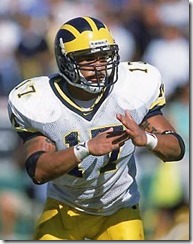 Scout leading up to his NFL draft year:
Scout leading up to his NFL draft year:
THE GOOD: Quick, athletic linebacker that flies around the football. Explosive first step moving to action, scrapes well laterally and pursues the ball carrier with speed. Effectively redirects to the ball carrier, displays a quick and fluid change of direction and shows excellent range in pass coverage. Gets depth on his drops, adequate footwork covering backs or tight ends off the line of scrimmage and can play in space. Works hard, plays with reckless abandon and goes sideline to sideline for 60 minutes.
THE BAD: Small, slow shedding blocks or rather easily moved out of his angle of attack. Lacks body control and may not have the flat out speed to be considered at strong safety.
The Steelers used Foote in much the same way Michigan deploys its weakside linebacker.
What to look for in a Scouting Report: Read the print, not the rankings. Michigan fans haven't had much exposure to middle linebacker scouting because other than Demens (and that after some major convincing) Michigan recruited like none of them. If you dive into reports on some State guys who worked out well despite not having elite speed (Greg Jones, Eric Gordon, Max Bullough) you'll see instincts and ability to shed blocks highlighted. Going the other direction, there's very hyped large safeties (e.g. Ohio State's Ryan Shazier, or Michigan's Prescott Burgess) who with coaching and just enough instincts can become pretty good college WLBs using their athleticism, with the caveat of also being candidates for big plays. If he does have those instincts to go with the athleticism you can get a guy like Nebraska's 2012 star LB Lavonte David.
"Instincts" unfortunately has become the next most-used word to describe prospects after "stud" so its utterance in a scouting report, especially from his coach, doesn't speak as loudly as its lack. "Stiffness" gets thrown in a lot because high school LBs don't typically have very good hip technique yet, though if it gets repeated often enough a move down to SAM may be in the cards.
What you can learn on film: Same stuff that you see in great middle linebackers on any level: quick reflexes, defeats blocks. It's easier to spot a great coverage LB by watching a game not highlights, since you begin to notice the team has great pass defense but can't quite put a finger on why nobody seems to be open.
What could signal bust potential: I've seen enough to be wary of safety-types who project to MLB. Athleticism is overrated but in high school it's hard to see much else. This is why the future SAMs of America get to be the highly rated linebackers year-in/-out. Coaches love big hitters but the big hitters are really the guys who got themselves in position to do that. A guy within the Penn State recruiting footprint without a PSU offer could be a red flag.
How our guys compare: We're fond of repeating the "Desmond Morgan will hit ya" meme.  From his play in his underclassman years he has come across as a jack-of-all linebacker. Moving to MIKE is a natural progression since he's by now better at dealing with blockers and Demens is out of the way. He's rugged and while not alarm bells instinctual, he had enough in that category to start as a true freshman.
From his play in his underclassman years he has come across as a jack-of-all linebacker. Moving to MIKE is a natural progression since he's by now better at dealing with blockers and Demens is out of the way. He's rugged and while not alarm bells instinctual, he had enough in that category to start as a true freshman.
Scouting reports for last years freshmen spam that instincts button. James Ross (right) showed Harris-like read speed although he was too small last year to do much with it. Joe Bolden's recruiting reports also made him out to be a natural, though he less so than Ross in action last year. Put that in perspective: while playing over established starters and a classmate on the same level true freshman Bolden was only a serviceable Big Ten linebacker. The upside on a guy who is that as a true freshman is huge. Unfortunately that upside makes up a big part of Michigan's linebacker account's valuation. Big jumps from size increases and experience are expectable, but also necessary to make the leap into Walsh-approved players.
The sole leftover here from the Rodriguez years is (Who?) Mike Jones, a safetyish guy who was questionable to receive a 5th scholarship year but has seen spotted time in certain packages and who may be useful in pass protection. Antonio Poole was a quick Hoke commit when Brady arrived to find he'd be completely out of linebackers in a few years. A WLB project his career has been set back due to a workout injury that threatened his career.
Last year's other used freshman Royce Jenkins-Stone is a big-time athlete who probably should have redshirted and has MGoBlog confused due to his being placed among the MLBs instead of being trained as a SAM. His byword is "aggressive" but instincts are kindly discussed among "areas of improvement." A bit of play last year did nothing to remove his being typecast as a wrecking ball-sort.
Kaleb Ringer played injured until he could no longer as a senior and missed last year to another injury. His scouting report initially brought up imagery of afore mentioned State linebackers or Carr-era two-down run stoppers like Sam Sword, except he stopped growing and dipped down the rankings as a senior. If he can help it'll be down the road most likely. Ben Gedeon is a consensus 4-star and OLB to everybody, checks the requisite instincts box and gets people talking about his athleticism. He's a future WILL.

